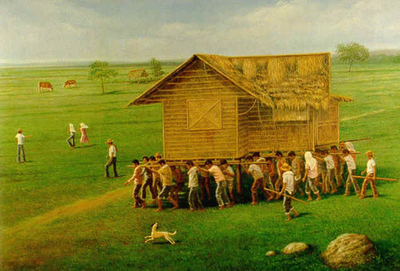
When I landed in
I had worked in
Of course I wasn’t happy about every change that had taken place. The World Bank reports that air pollution kills 2,000 Filipinos a year. In addition, in the cities of Metro Manila,
Automobiles create 80 percent of the pollution, reducing everyone’s life expectancy. Tiny particles (“particulate matter”) penetrate deep into respiratory tissue and directly into the bloodstream. The good news is that eating more fresh fruits and vegetables help to reduce the creation of “free radicals” in the body caused by this particulate matter.
Deforestation has also worsened. From 1980 to 2000 the total forest coverage in Maharlika was reduced by half! Today only 19 percent of the country is covered by forest. The tragic results are land degradation, erosion, flash floods, draught and mudslides. (Ian Coxhead and Sisira Jayasuriya, “Environment and Natural Resources” in The Philippine Economy: Development, Policies and Challenges,
The West prides itself on its science and technology, yet it ignores the warnings of world scientists about the effects of pollution and global warming. First in 1992, scientists from around the world signed a joint letter asking world leaders to sign the global warming treaty at
Predictably, these compelling warnings have been for the most part ignored by the mainstream media in the
I checked the Forbes magazine website (www.forbes.com) to see who are the richest Filipinos – as expected, the three billionaires were also the wealthiest people 20 years before:
- Lucio Tan, self-made wealth from cigarettes, liquor, Philippine Airlines and Philippine National Bank. Total worth: US$ 1.7 billion.
- Henry Sy & family, self-made, owns 23 shopping malls: US$1.5 billion.
- Jaime Zobel de Ayala & family, inherited, Ayala Corporation owns real estate, water and telecom: US$1.3 billion.
By checking the Forbes lists during the last ten years, it can seen that each one is two to three times richer. So I asked each audience, “Are you?” Invariably the reply came, “No, we’re poorer!”
Professor Arsenio M. Balisacan of the University of the Philippines in his article “Poverty and Inequality” in The Philippine Economy: Development, Policies and Challenges, Oxford University Press, 2003 gives many statistics demonstrating how the widening gap between rich and poor has resulted in most of the gains of national economic growth being eaten up by the rich, leaving the poor with very little benefit.
Of course Prout’s response to this extraordinary widening gap between rich and poor is to remind everyone that the world’s physical resources are limited. If individuals accumulate too much, there will not be enough for everyone. So every country should decide maximum salaries, wealth and land ownership. The only reason to pay more is to motivate people to make a greater effort to benefit society.
I had the pleasure of meeting again Alejandro Lichauco, a radical economist cited in the bibliography of my book. His most recent work is Hunger, Corruption and Betrayal: A Primer on

2 comments:
thanks for your words and sharing your consciousness. Mabuhay.
THe Filipinos should be united for Philippine gold.Germany trie dto reclaim its gold from the US but it can't claim any. Tell our leaders to followup on our gold in the US
http://asiatikistic.blogspot.com/2013/10/if-germany-cant-recover-promptly-half.html
Post a Comment